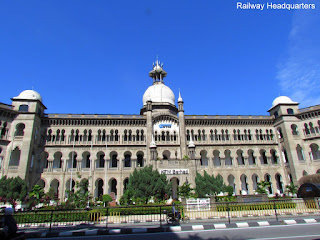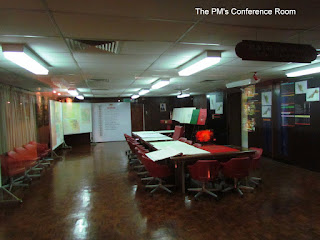KL broke into the list of top 10 cities with the most international arrivals in 2012, but it seemed to have no appeal for me. The iconic Twin Towers? Seen enough of skyscrapers in NYC and Chicago. Shopping? Its tough to get me to the neighborhood mall to shop, let alone another country. The casinos at nearby Genting? Never bet a dollar on blackjack or baccarat in my life. It is only when I moved to Singapore did I think that I must visit KL, which was just a few hours' bus ride away. And when I did go earlier this month, I realized there was much more to the place than I anticipated.
I traveled alone as Jyoti was in India. I took the overnight coach to Genting. Border crossings by land have a different feel as compared to taking international flights: most co-passengers tend to be locals who do this frequently, and they change countries with a sense of comfort and familiarity I have when paying for toll at the sea link or changing trains at Dhoby Ghaut.
The bus reached the fog-covered Genting highlands at a nippy 5 am, at least a couple of hours earlier than I had anticipated. However, like money, a casino never sleeps. There was enough activity to make it worthwhile strolling around, watching the curious cast of characters, all believing lady luck will shower her favors on them at the next flip of the slot machine, or the following roll of the dice. The place was old and tacky, and customer service is non-existent: when I asked a guard for directions, he waved his hand randomly, which could have meant straight, right or left. Maybe this was a metaphor for the casino: trust your luck and pick one of the options! I did, however, see the reason for its stupendous success: it had something for everyone. Papa could hit the casino, Mama the shopping arcade, and Kiddo the amusement park, at a price a fraction of what you would pay in neighboring Singapore.
But there was little that I found interesting, and took the morning's first public bus to KL. I had booked a room at Explorers' Guesthouse, an inexpensive hostel located in Chinatown. It had a spacious lobby area, with the reception desk on one side, the TV lounge in one corner, and some breakfast tables in another, all combining to give you a warm, homely feeling without looking cramped. In another corner, a spiral staircase led to the rooms, painted recently in warm pastels, and containing nothing but a bed, table and a couple of paintings. The bathroom door had an old fashioned wooden bolt running across its width, oozing a rustic charm in the middle of a bustling city.
I dropped my backpack in the room, picked up a city map and set about exploring on foot. Right behind the hostel was the covered Central Market (Pasar Seni) and adjacent to it, a street of hawkers dubbed the Kasturi Walk. I was famished by now and bought a vegetarian roll: it was surprisingly tasty as it was just cheese, onions and a sprinkling of herbs curled up in a soft roti. Thereafter I walked across the river Klang - its adds no more charm to KL than the Tiber does to Rome or the Yamuna to Delhi - to the heritage area, which was quintessentially British Colonial. The Sultan Abdul Samad building reminded me of Mumbai University, and at the sight of Merdaka Square, I half expected two teams of eleven each, dressed in white flannels, to walk out for a game of cricket.
It was about post noon as I took a train to the 120-year old Batu Caves, dedicated to Lord Murugan, located a few miles north of the city. The short but steep climb upto the temple cave was punctuated by curious tourists either feeding or fleeing the monkeys around. There were small restaurants at the base of the cave serving idlis and dosas, and playing traditional devotional music. It felt very much like a shrine in South India. After all this walking and roaming in the heat - KL is hot even in January - I headed back to the guesthouse to get a couple of hours' sleep.
The evening was dedicated to explore the modern face of KL. I took the train from Masjid Jamek to KLCC to reach the Twin Towers, and both stations' designs impressed me: the advertising, the artwork and the quality of the materials. There isnt really much to say about the Petronas Towers: you get exactly what you expect. But I was impressed by the choice of cuisines available at the food court in the Suria Mall. It struck me that there were no known brands, but you still had everything from Norwegian sandwiches to Afghan Kebabs. I picked up a Cheese Quesadilla: considering what I expected from a randomly chosen stall at one of the many malls in a country almost antipodal to Mexico, it was mucho delicioso.
After dinner, I walked through the maze of modern bank buildings on to Bukit Bintang, the heart of the city's nightlife. Modern malls alongside hole-in-the-wall hotels, foot spas and Ferraris, hawker centres next to Middle Eastern restaurants, this is the place to be once the sun goes down. I walked around, gazing and soaking the sights, and when I got tired, called it a day.
The next morning, I headed southwest to explore more heritage buildings. As I walked past the old Kuala Lumpur station, I was struck by the chhatris at each corner of this hundred year old building, clearly reflecting the import of architectural forms from British India to British Malay. Adjacent to the station was the building of KTM Berhad (the Malaysian Railway), its Victorian style reminding me of VT station minus the hustle-bustle.
The old gave way to the new at the next stop, the National Mosque. There wasn't a single curved surface in the entire building, which made it unlike any mosque I have visited. The pillars widened rather than narrowed with height, and the main roof made me think of a Sydney Opera House with flat surfaces. It was a big building with fountains and reflection pools, and one could sit near a pillar in one of the hallways for a moment of peace.
Beyond the mosque was a large expanse of greenery, dotted with ecological attractions like the KL Bird Park, Orchid Garden and the Butterfly Garden. I skipped those and instead paid a visit to the memorial of Malaysia's second Prime Minister Tun Razak, who kickstarted major economic and political reforms during his tenure in the late 60s. The complex was earlier the PM's residence and office and is now a museum, albeit a biased one that omits the details of the racial tensions that governed Malay politics during that time.
A short descent behind the memorial was the Perdana lake, with a walking path and gardens along its periphery. Though it was around noon and Malaysians are not exactly fond of soaking in the sun, I was surprised there there were no more than 3-4 people around. For a moment, I wondered if KL had a Friday-Saturday weekend, but recalled that I hadn't noticed anyone who seemed to be going to work earlier in the day: perhaps the area would fill up towards the evening.
My final stop for the day was the National Museum. I think it is a must-see attraction, especially for those who plan to see more of Malaysia. It is divided into four sections: prehistoric sites, the Malay Kingdoms, the Colonial Period and post-Independence period. I added the ancient port city of Malacca as a must visit place after reading about its rich history. Right outside the museum, there was some construction going on for a new subway line. I was impressed by the humor of those in charge of the project: the generic "Inconvenience is Regretted" sign was substituted by the words "This too shall pass - Persian Poet" all over the work zone.
Everytime I visit a city, I try to pass through its main train station: it tends to encapsulate the essence of the place. Do the locals add sugar and milk to their tea? Whats the latest scandal on the political front? Is the average Joe as friendly as the hotel concierge or the museum guide? How big the city really is?
Within walking distance of the museum was KL Central, where all the long distance and local train lines converged. Often a city's train system is termed its lifeline. If that is so, then KL Central was akin to its heart: busy and bustling, energetic and efficient. I had a quick bite to eat at McDonalds, took the train to the hotel, and headed to the bus station to take the evening coach back to Singapore.
KL wouldn't make it to my list of favorite cities - it doesnt have that x-factor that makes it unforgettable - but given the proximity, I certainly would like to visit again: check out the restaurants, visit the KL tower and some museums, even do some essentials' shopping there as its cheaper than Singapore. The short trip, however, has primed me for the exciting possibilities that await in Malaysia: I can't wait to check out the heritage in Penang, experience the rainforest in Borneo, or go diving in Tioman or Redang.












Superbly written! And also very precise! Loved all the pictures.The stair case at the station (Masjid Jamek or maybe KLCC) is quite intresting.
ReplyDeleteThanks Rachna, appreciate you taking the time to read it.
ReplyDeletethe mosque looks pretty posh and 5*types. when u were there did u find anybody praying?
ReplyDeleteIt was a Sunday late morning. I do not know if that was Namaz time. There were not too many people there. But the place was situated away from residential areas, so not sure if too many people would visit daily.
Deletetoo good to be a mosque
Deletethst explains
DeleteYou should do what you love to do, not what others think about you. This will bring peace, happiness and mastery of subject and your self.
ReplyDelete